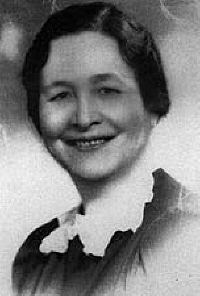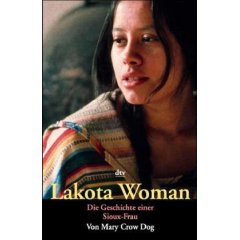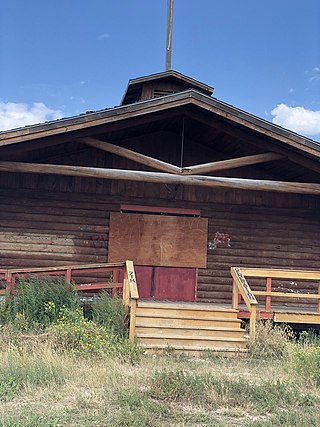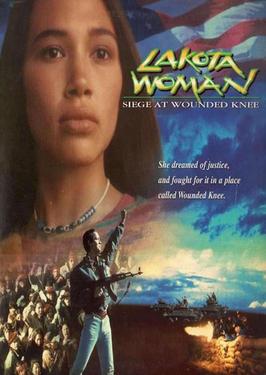Related Research Articles

The Ghost Dance is a ceremony incorporated into numerous Native American belief systems. According to the teachings of the Northern Paiute spiritual leader Wovoka, proper practice of the dance would reunite the living with spirits of the dead, bring the spirits to fight on their behalf, end American Westward expansion, and bring peace, prosperity, and unity to Native American peoples throughout the region.

The Wounded Knee Massacre, also known as the Battle of Wounded Knee was a massacre of nearly three hundred Lakota people by soldiers of the United States Army. The massacre, part of what the U.S. military called the Pine Ridge Campaign, occurred on December 29, 1890, near Wounded Knee Creek on the Lakota Pine Ridge Indian Reservation in South Dakota, following a botched attempt to disarm the Lakota camp. The previous day, a detachment of the U.S. 7th Cavalry Regiment commanded by Major Samuel M. Whitside approached Spotted Elk's band of Miniconjou Lakota and 38 Hunkpapa Lakota near Porcupine Butte and escorted them five miles westward to Wounded Knee Creek, where they made camp. The remainder of the 7th Cavalry Regiment, led by Colonel James W. Forsyth, arrived and surrounded the encampment. The regiment was supported by a battery of four Hotchkiss mountain guns. The Army was catering to the anxiety of settlers who called the conflict the Messiah War and were worried the Ghost Dance signified a potentially dangerous Sioux resurgence. Historian Jeffrey Ostler wrote in 2004, "Wounded Knee was not made up of a series of discrete unconnected events. Instead, from the disarming to the burial of the dead, it consisted of a series of acts held together by an underlying logic of racist domination."

Wovoka, also known as Jack Wilson, was the Paiute religious leader who founded a second episode of the Ghost Dance movement. Wovoka means "cutter" or "wood cutter" in the Northern Paiute language.

Ella Cara Deloria, also called Aŋpétu Wašté Wiŋ, was a Yankton Dakota (Sioux) educator, anthropologist, ethnographer, linguist, and novelist. She recorded Native American oral history and contributed to the study of Native American languages. According to Cotera (2008), Deloria was "a pre-eminent expert on Dakota/Lakota/Nakota cultural religious, and linguistic practices." In the 1940s, Deloria wrote the novel Waterlily, which was published in 1988 and republished in 2009.

The Ghost Dance War was the military reaction of the United States government against the spread of the Ghost Dance movement on Lakota Sioux reservations in 1890 and 1891. The U.S. Army designation for this conflict was Pine Ridge Campaign. White settlers called it the Messiah War. Lakota Sioux reservations were occupied by the U.S. Army, causing fear, confusion, and resistance among the Lakota. It resulted in the Wounded Knee Massacre wherein the 7th Cavalry killed over 250 Lakota, primarily unarmed women, children, and elders, at Wounded Knee on December 29, 1890. The end of the Ghost Dance War is usually dated January 15, 1891, when Lakota Ghost-Dancing leader Kicking Bear decided to meet with US officials. However, the U.S. government continued to use the threat of violence to suppress the Ghost Dance at Lakota reservations Pine Ridge, Rosebud, Cheyenne River, and Standing Rock.
Mary Brave Bird, also known as Mary Brave Woman Olguin and Mary Crow Dog was a Sicangu Lakota writer and activist who was a member of the American Indian Movement during the 1970s and participated in some of their most publicized events, including the Wounded Knee Incident when she was 18 years old.

Lakota Woman is a memoir by Mary Brave Bird, a Sicangu Lakota who was formerly known as Mary Crow Dog. Reared on the Rosebud Indian Reservation in South Dakota, she describes her childhood and young adulthood, which included many historical events associated with the American Indian Movement.

The Wounded Knee Occupation, also known as Second Wounded Knee, began on February 27, 1973, when approximately 200 Oglala Lakota and followers of the American Indian Movement (AIM) seized and occupied the town of Wounded Knee, South Dakota, United States, on the Pine Ridge Indian Reservation. The protest followed the failure of an effort of the Oglala Sioux Civil Rights Organization (OSCRO) to use impeachment to remove tribal president Richard Wilson, whom they accused of corruption and abuse of opponents. Additionally, protesters criticized the United States government's failure to fulfill treaties with Native American people and demanded the reopening of treaty negotiations to hopefully arrive at fair and equitable treatment of Native Americans.
Samuel Benton Callahan was an influential, Muscogee politician, born in Mobile, Alabama, to a white father, James Callahan, and Amanda Doyle, a mixed-blood Creek woman. He is listed as 1/8th Creek by Blood on the Dawes Rolls. One source says that James was an Irishman who had previously been an architect or a shipbuilder from Pennsylvania, while Amanda was one-fourth Muscogee. His father died while he was young; he and his mother were required to emigrate to Indian Territory in 1836. His mother married Dr. Owen Davis of Sulphur Springs, Texas, where they raised Samuel.

Ghost shirts are shirts, or other clothing items, worn by members of the Ghost Dance religion, and thought to be imbued with spiritual powers. The religion was founded by Wovoka, a Northern Paiute Native American, in the late 19th century and quickly spread throughout the Indigenous peoples of the Great Basin and Plains tribes.

James McLaughlin was a Canadian-American United States Indian agent and inspector, best known for having ordered the arrest of Sitting Bull in December 1890, which resulted in the chief's death and contributed to the Wounded Knee Massacre. Before this event, he was known for his positive relations with several tribes. His memoir, published in 1910, was entitled, My Friend the Indian.

Mourning Dove or Humishuma was a Native American author best known for her 1927 novel Cogewea, the Half-Blood: A Depiction of the Great Montana Cattle Range and her 1933 work Coyote Stories.

Lakota Woman: Siege at Wounded Knee is a 1994 TNT film starring Irene Bedard, Tantoo Cardinal, Pato Hoffmann, Joseph Runningfox, Lawrence Bayne, and Michael Horse and August Schellenberg. The film is based on Mary Crow Dog's autobiography Lakota Woman, wherein she accounts her troubled youth, involvement with the American Indian Movement, and relationship with Lakota medicine man and activist Leonard Crow Dog. The film is notable for being the first American film to feature an indigenous Native American actress in the starring role. Lakota Woman is also the third overall and first sound film with an entirely indigenous cast after In the Land of the Head Hunters and Daughter of Dawn.

Spotted Elk, was a chief of the Miniconjou, Lakota Sioux. He was a son of Miniconjou chief Lone Horn and became a chief upon his father's death. He was a highly renowned chief with skills in war and negotiations. A United States Army soldier, at Fort Bennett, coined the nickname Big Foot – not to be confused with Oglala Big Foot.
Gloria Bird is a Native American poet, essayist, teacher and a member of the Spokane Tribe in Washington State. Gloria spreads her work not only by writing for her but all Native American people. In her work, Bird’s main priority is to question and diminish harmful stereotypes placed on Native American people. Her focus in on educating about her community in accurate scripts without exploiting the culture.

Sophia Alice Callahan was a novelist and teacher of Muscogee heritage. Her novel, Wynema, a Child of the Forest (1891) is thought "to be the first novel written by a Native American woman." Shocked about the Massacre at Wounded Knee at the Pine Ridge Indian Reservation, which took place about six months before she published her book, Callahan added an account of this and the 1890 Ghost Dance of the Lakota to her book in the first fictional treatment of these subjects. This may have been "the first novel written in Oklahoma," which was at the time Indian Territory. Callahan wrote in a romantic novel style but she also clearly intended what has been called a "reform novel," identifying many wrongs suffered by Native Americans in United States society. After being discovered in the late 20th century, the novel was reprinted in 1997. It has been the subject of scholarly studies.

Zintkála Nuni, alternatively 'Zintka Lanuni', was a Lakota Sioux woman who was a 4-month-old infant when she was found alive among the victims at the Wounded Knee Massacre.
Emma Cornelia Sickels (1854–1920) was an American teacher. She had a complex relationship with Indigenous peoples through her work with the United States government. White society regarded her as a hero for collecting information and mediating peace between the US and the Lakota people in 1890. During this time, she incorrectly blamed Native Americans for the Wounded Knee Massacre. In 1893, she was publicly fired from the Anthropology and Ethnology Department at the Chicago World's Fair for protesting how her boss was falsely showcasing Native American life to display Indigenous people as uncivilized.
References
- ↑ Siobhan Senier, "Allotment Protest and Tribal Discourse: Reading Wynema's Successes and Shortcomings" Archived 2015-11-05 at the Wayback Machine , The American Indian Quarterly, Volume 24, Number 3, Summer 2000, pp. 420-440
- 1 2 3 4 5 6 7 8 9 "Behind the Shadows of Wounded Knee: The Slippage of Imagination in 'Wynema: A Child of the Forest'" Archived 2016-03-04 at the Wayback Machine , Lisa Tatonetti, Studies in American Indian Literatures, Volume 16, Number 1, Spring 2004, pp. 1-31 | 10.1353/ail.2004.0015
- ↑ Janet Dean, "Reading Lessons: Sentimental Literacy and Assimilation in 'Stiya: A Carlisle Indian Girl at Home' and 'Wynema: A Child of the Forest'," Archived 2022-10-17 at the Wayback Machine ESQ: The Journal of the American Renaissance, Volume 57, Number 3, 2011 (Nos. 224 O.S.), pp. 200-240; available at Digital Commons; accessed 6 August 2016
- ↑ Bakken & Farrington 2003, p. 42.
- ↑ Bataille & Lisa 2003, p. 63.